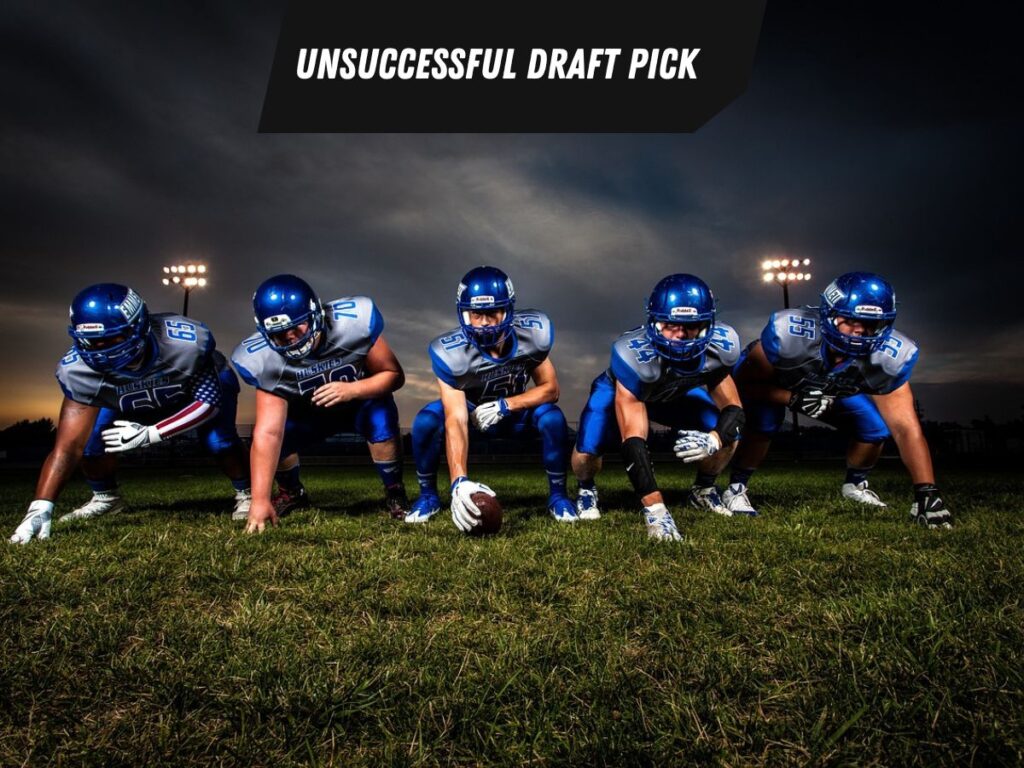
The draft. A nerve-wracking, exhilarating spectacle for fans and franchises alike. Teams pore over statistics, watch countless game tapes, and conduct interviews in an effort to unearth the next generation of superstars. But the reality of the draft is a double-edged sword. While some picks blossom into Hall of Famers, others leave a trail of disappointment, forever branded as “Unsuccessful draft picks.”
This article delves into the intriguing, yet often overlooked, aspect of sports management: the unsuccessful draft pick. We’ll explore how these picks can make or break a team’s future, the factors that contribute to them, and the impact they have on the competitive landscape across various leagues.
The High Stakes of the Draft
The draft is a pivotal moment for any professional sports franchise. It’s an opportunity to inject fresh talent, fill key positions, and build a team for sustained success. Here’s why the stakes involved are so high:
- Limited Roster Size: Unlike some other sports, professional leagues like the NFL or NBA have limitations on the number of players a team can carry on its active roster. Every draft pick represents a significant investment of resources, both financial and in terms of coaching time.
- Salary Cap: Many leagues enforce a salary cap, restricting the amount of money a team can spend on player salaries. A bad draft pick can tie up valuable cap space for years, hindering the team’s ability to sign other players.
- Long-Term Commitment: Draft picks, especially high ones, are often signed to multi-year contracts. This means a team is financially committed to a player even if they underperform.
Anatomy of an Unsuccessful Draft Pick: A Multifaceted Issue
Draft busts can stem from various factors, making it a complex issue. Here’s a breakdown of some key contributors:
- Misévaluation of Talent: This is perhaps the most common culprit. Teams might overestimate a player’s potential based on college stats or a limited scouting view. Factors like poor work ethic, lack of motivation, or inability to adapt to the pro game can contribute to this misjudgment.
- Injury Prone Players: Even the most talented player can be derailed by injuries. Teams must carefully assess a player’s medical history and injury risk before drafting them high.
- Scheme Misfit: A player might possess exceptional talent, but if they don’t fit well within the team’s offensive or defensive scheme, their impact can be diminished.
- Character Issues: Off-field problems can derail a promising career. Teams need to investigate a player’s character thoroughly before investing a high draft pick in them.
Here’s a table summarizing the factors that contribute to unsuccessful draft picks:
| Factor | Description |
|---|---|
| Misévaluation of Talent | Overestimating a player’s potential |
| Injury Prone Players | High risk of injuries hindering performance |
| Scheme Misfit | Player doesn’t fit the team’s playing style |
| Character Issues | Off-field problems impacting career |
Impact on the Competitive Landscape
Unsuccessful draft picks have a ripple effect across the league, impacting the competitive landscape in several ways:
- Power Imbalance: Teams with a string of draft busts can fall into a cycle of mediocrity, struggling to compete with franchises that consistently draft well.
- Free Agency Frenzy: A team with a lack of homegrown talent might be forced to overpay in free agency to fill the gaps, impacting financial flexibility.
- Coaching Carousel: The pressure to win can lead to coaching changes as fans and ownership blame the coaching staff for poor draft decisions.
Case Studies: Busts Who Shaped the Game
Let’s delve into a few real-life examples of unsuccessful draft picks that significantly impacted their respective teams:
- Ryan Leaf (NFL, 1998): Touted as the potential successor to Dan Marino, Leaf’s NFL career was marred by inconsistency, off-field issues, and injuries. The San Diego Chargers, who drafted him second overall, never recovered from this misstep, plunging into a period of struggle.
- Kwame Brown (NBA, 2001): The Washington Wizards selected Brown, a high school phenom, with the first overall pick. Brown’s underwhelming career, filled with unfulfilled potential, became a cautionary tale for teams relying solely on physical attributes when drafting young players.
- JaMarcus Russell (NFL, 2007): The Oakland Raiders drafted Russell first overall, hoping he’d become their franchise quarterback. However, Russell’s work ethic issues and inconsistent play resulted in a bust, hindering the Raiders’ development for years.
FAQs for Unsuccessful Draft Picks
Q: Are all high draft picks busts?
A: No, thankfully! Many high draft picks become stars in their respective leagues. However, the pressure and potential downside are significantly higher for these selections.
Q: Can unsuccessful draft picks be traded?
A: Yes, teams can trade draft picks, even players who haven’t lived up to expectations. However, their trade value will be significantly lower due to their status as a “bust.”
Q: How do teams try to avoid draft busts?
A: Teams employ extensive scouting processes, including:
- Analyzing college game film
- Conducting player interviews
- Evaluating medical records
- Performing psychological evaluations
- Studying a player’s character and work ethic
Q: Can a team recover from a bad draft pick?
A: Absolutely! While it might take some time and smart maneuvering, teams can overcome draft busts through savvy trades, free agency acquisitions, and successful future drafts.
Conclusion: The Draft – A Calculated Gamble
The draft is a cornerstone of building a successful sports franchise. It’s a calculated gamble, a chance to unearth hidden gems and propel a team towards championship glory. However, the reality is that even with the best scouting and evaluation systems in place, some picks will disappoint. Understanding the factors that contribute to unsuccessful draft picks, their impact on the league, and learning from past mistakes are all valuable tools for teams aiming to navigate the draft with greater success.
The draft isn’t just about finding the next superstar; it’s about identifying players who fit seamlessly into the team’s system and contribute to a winning culture. While some picks might not pan out, the constant pursuit of talent through the draft remains a vital process in the ever-evolving world of professional sports.










